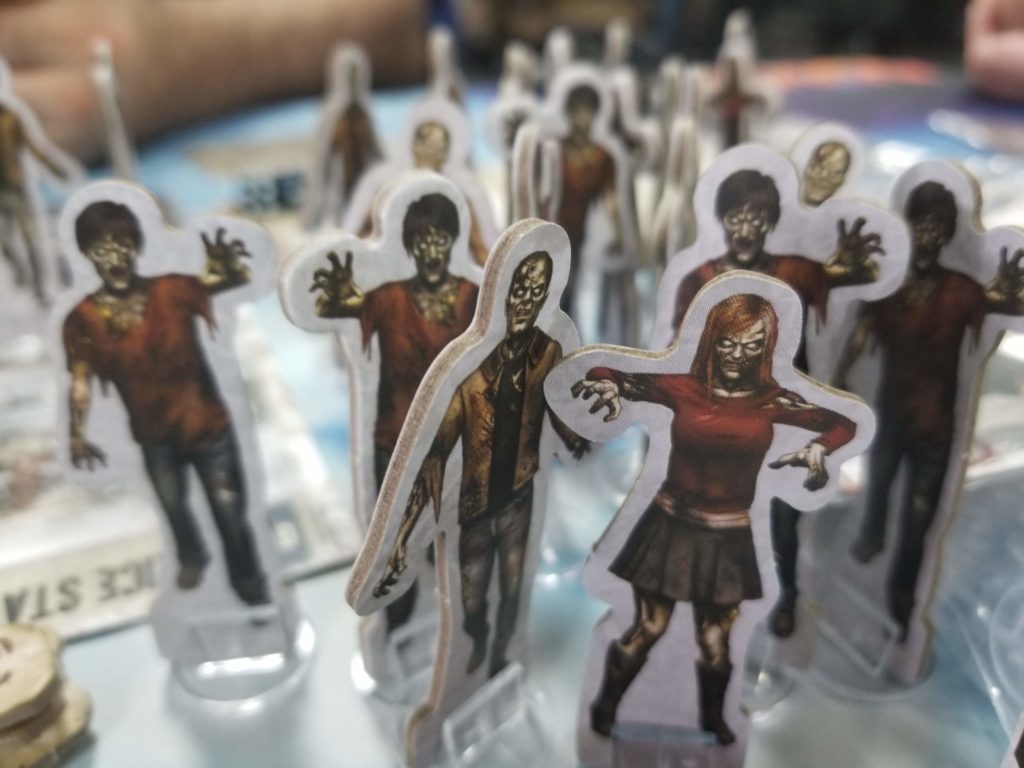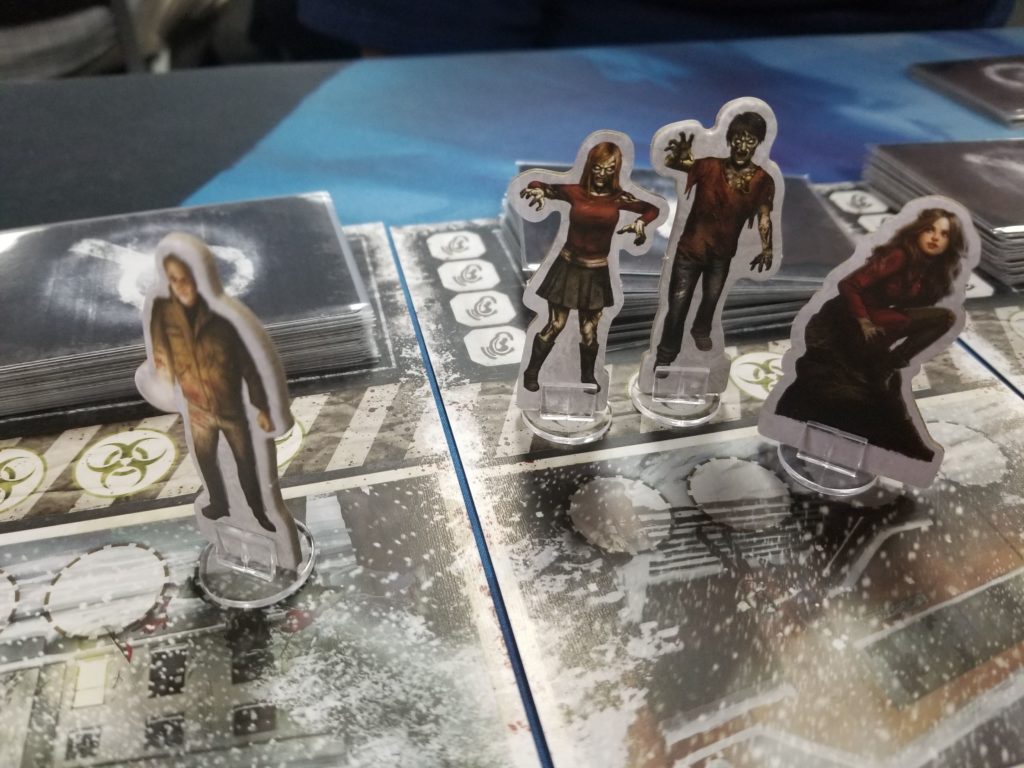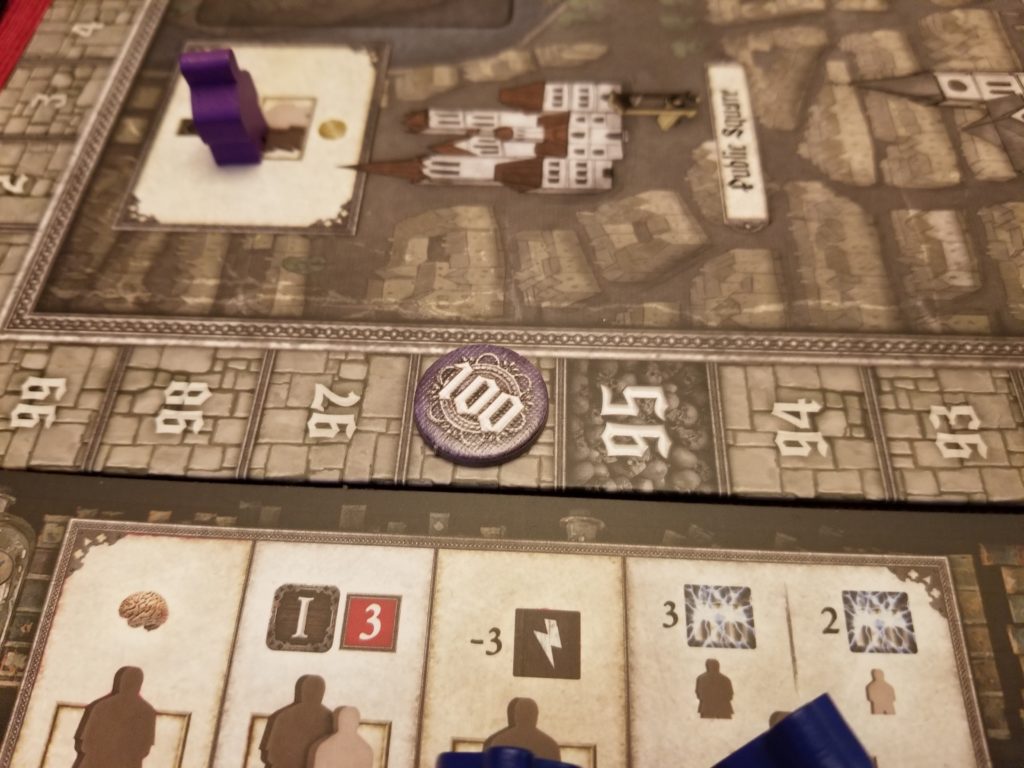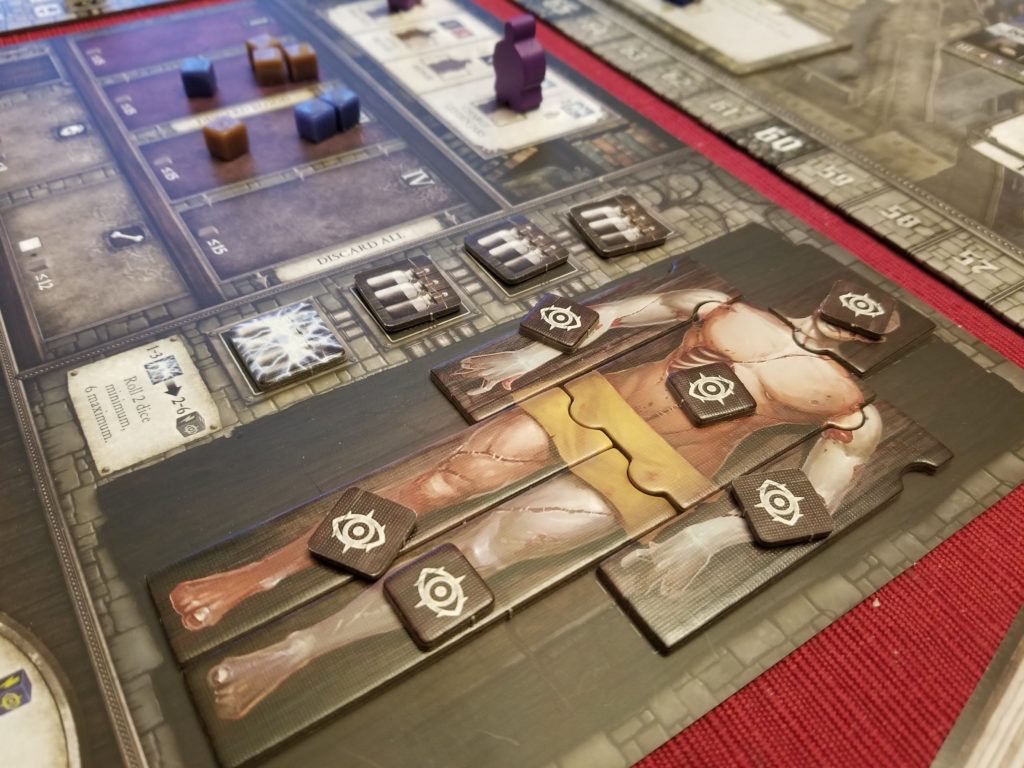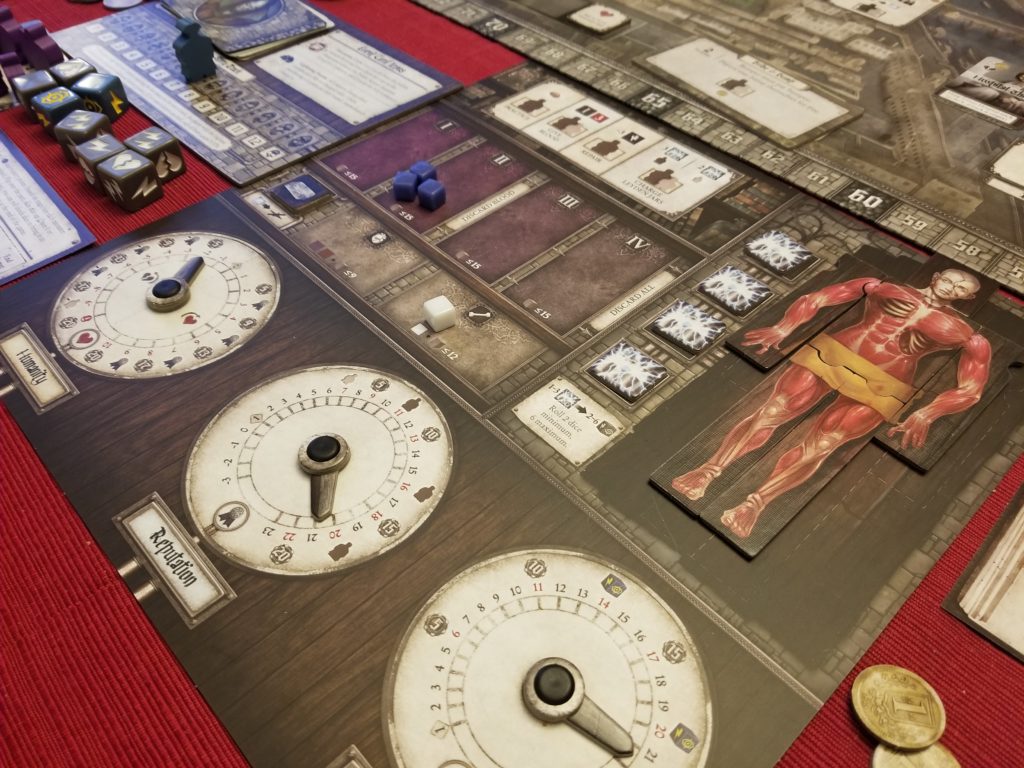Estimated delivery March 2021
Here to Slay Backed by Unplugged
Dead of Winter
[bgg id=150376]
Participants
- Andrew – winner
- Mark
- Sean
- Robert
- Brian
Rules missed
- not a misplayed rule, but we did forget that a number of zombies are added to each location equal to the number of survivors at the location at the end of the round – this led to 2 or 3 of Mark’s survivors being “overun” (that’s dead) at the end of one round
BGG clarifications
- none
Photos
About the game
This “mostly-cooperative” game features players as members of a colony of survivors trying to live through winter during a zombie apocalypse. The players will have a shared colony objective detailed on a scenario card, plus each player will have their own secret objective, too. In our game the colony objective was to collect a variable number of dead (re-dead? extra dead?) zombies.
The game is “mostly-cooperative,” because one of the players may have been dealt a betrayal card, which means they will be secretly working against the best interests of the colony. This element means that you can never be to sure of the motivations of the other players, which can lead to suspicion, and sometimes a player being voted out of the colony, which has benefits or penalties based on whether the player exiled was the betrayer or not.
During a turn, each player rolls dice and uses equal to the number of survivors they control +1, and uses those dice to perform actions around the game board. Survivors can travel to locations around the colony, search those locations, battle zombies, use items, clean up the colony, contribute cards to each round’s “crisis,” and more. Many actions can expose players to wounds, frostbite, or dreaded zombie bites. Crossroads cards are an interesting feature of the game. At the beginning of your turn, another player will read a Crossroads card for certain gameplay “triggers.” If, during your turn, you perform actions that trigger the card, it is read out loud, and you, or the other members of the colony will have two or more story choices to make that will affect the game in a variety of ways.
Each scenario has it’s own victory conditions and predetermined number of rounds. The game ends when the victory conditions have been met, the final round is completed, or when colony morale reaches zero (in our game’s case, our morale reached zero, which led to Andrew revealing himself as the betrayer and claiming victory based on his win conditions).
Final Thoughts
This game does a great job of simulating survival in a freezing zombie apocalypse. There is always another crisis to manage, and more and more zombies to deal with. It’s very thematic, and the Crossroads cards provide a bit of story to enhance gameplay. The possibility of a betrayal player creates a great deal of suspicion and tension around the table. It might be best to play this game with people you know well.
Parks: Nightfall backed by Unplugged
Estimated delivery September 2020
Meet the Team
Katey & Sean – owner/operators
Sean has been an avid tabletop gamer for more than 30 years. He worked in the foodservice industry for almost 15 years, in restaurants but also as a sales representative for a national distributor. After many years in the foodservice industry, Sean is now in his sixth year as an elementary school teacher, where he combines his love of fun and games with a passion for education, and working with kids. He runs an afterschool board game club for 5th graders, helping students learn about strategy, probability, sportsmanship, and more. Sean especially enjoys living card games like Lord of the Rings: the card game, and Marvel: Champions.
Katey has spent 20 years in the customer service and sales industry, working closely with clients, and building lasting relationships. She has held management positions, and worked as an industry educator and mentor to bring out the best in newly hired colleagues. She enjoys games, and planning and hosting events. Katey is an amatuer filmmaker and has appeared in several short films shot and premiered in the Richmond 48 Hour Film Festival. She is eager to use her passion for photography, film, and production to develop content for Unplugged! Katey routinely beats Sean in close games of Dominion.
Together, Katey and Sean own a collection of over 200 games, and today they share their love of fun and gaming with their two children. Avery & Emmett, ages 8 and 6, are already developing keen minds for strategy. Avery loves playing Loopin’ Louie, and Emmett rarely loses races in Flamme Rouge. Katey and Sean are excited to share their passion for games, food, and fun with the Richmond community by opening Unplugged!
Mark – owner/operator
Ever since playing Tank Battle in 1975, Mark has been hooked on all types of gaming. Since then, he has received a computer science degree, worked in the restaurant industry and written web software in the education, telecom and restaurant sectors. Now that his kids are headed off to college, he has time to put all those skills and passions together. Bringing his collection of over 300 board games, he is ready to provide the perfect atmosphere for bringing all types of people together to experience tabletop gaming.
Mark and Sean met in the early 90s over games of Magic the Gathering, Dungeons & Dragons, and Spades. They still get together regularly to enjoy both the latest and classic games.
The Expanse
[bgg id=220792]
Participants
- Mark
- Sean
- Katey – Winner
- Frank
Rules we Missed
- None found so far
BGG Clarifications
- Being able to move up to one band means you can also move within a band.
Photo
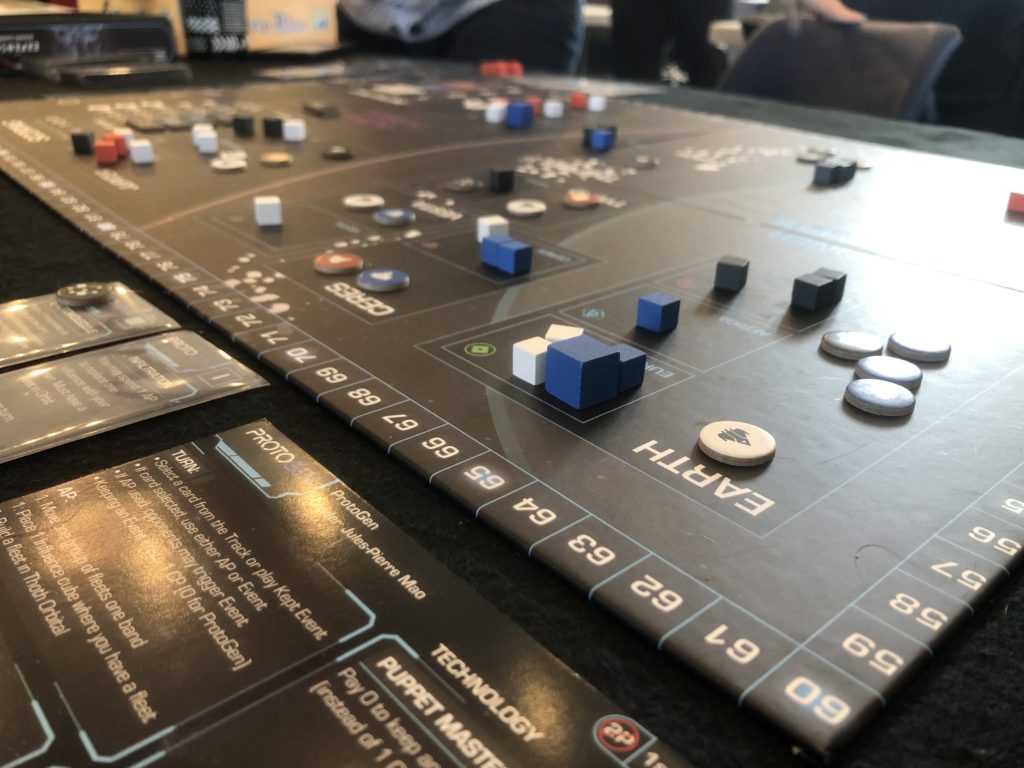
About the Game
This area control game plays well with 4 players. Rules are simple. On you turn, you have the option to purchase a card. Each card has a number of actions points and an event. Events can only be used by the factions shown on the card. Once you have chosen your card, you can either use the action points or the event. The action points allow you to move/build your fleets and establish influence in different areas. If you use the action points each faction shown the card has the option to use the event based on the order of the initiative track.
Once a scoring round is initiated, your influence and fleets are used to see who has control of each sector. Points are awarded based on this. The person in last place gains control of the Rocinante. this catch up mechanism gives the player extra options to use during the scoring round.
Final Thoughts
The theme of the game is nice for those that are familiar with the books or television show. However prior knowledge in no way affects gameplay.
The catch up mechanism works well. In our case the person in last, up until the 5th scoring round, won the game.
This game was a long one since we were learning straight from the instructions. Future games should be much quicker, since all the rules were very straight forward.
Oath: Chronicles of Empire and Exile Backed by Unplugged
Estimated Delivery: January 2021
Return to Dark Tower Backed by Unplugged
Estimated Delivery: February 2021
Red Outpost Backed by Unplugged
Abomination: The Heir of Frankenstein
[bgg id=239472]
Participants
- Katey
- Sean – winner
Rules missed
- When taking the graveyard or morgue actions in Paris, you may choose any number of cards drawn (0-x). The first few rounds, we only chose one card to collect resources from, and discarded the others.
Photos
About the game
Abomination: The Heir of Frankenstein is a worker placement game set in Paris 20 years after the events of Mary Shelley’s Frankenstein. The game is very thematic. A player’s “workers” are scientists and assistants. Most of the game is spent collecting “resources” players use to work towards assembling a creature and attempting to bring it to life. The resources needed for this macabre task are muscle, organs, bone, and blood (as a gruesome “wild” resource, players can substitute animal parts which results in fewer points). Players will also need to purchase and charge leyden jars that are used to roll dice that can bring body parts to life or damage your creature. One interesting aspect of the game are the 3 dials at the bottom of each player board, representing your character’s Humanity, Reputation, and Expertise; all 3 earn points at games end. Reputation will eventually attract new scientists and assistants to your cause (more actions), and Expertise is needed to assemble more difficult body parts, but the Humanity dial is much more interesting. Players need to carefully consider various methods for acquiring parts for their creature lest they themselves become a monster. There are a variety of event and encounter cards used to enhance the narrative during the game and slightly alter game play each round. Abomination is a neat new twist on basic worker placement. If you’ve played other worker placement games, it’s pretty easy to learn to play. It’s 2-4 players, and suggested play time is 90-180 minutes.
Final Thoughts
Abomination: The Heir of Frankenstein is a great addition to our library. The game is oozing (see what I did there?) with theme and atmosphere, and managing the dials was a neat puzzle to solve at times. Like many worker placement games, it can take several turns to build momentum, and late rounds can feel full of “filler” actions, but that may have been because we played with only 2 players. Katey and I really enjoyed Abomination, and we’re looking forward to trying it again, with different characters and/or additional players. Until next time!
